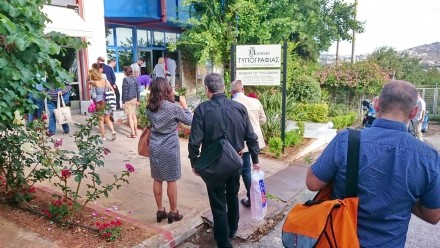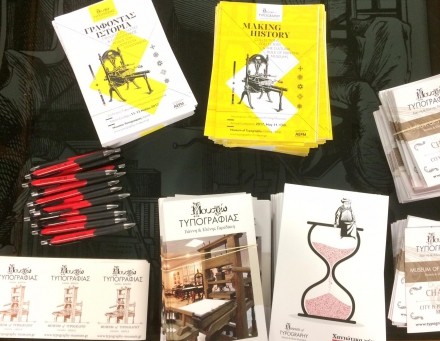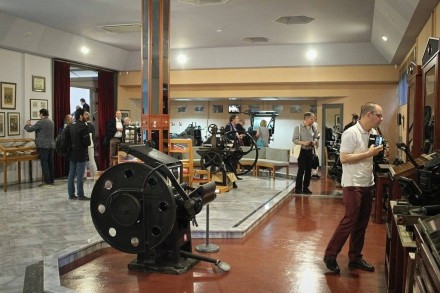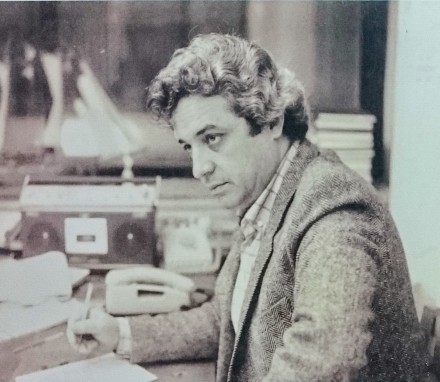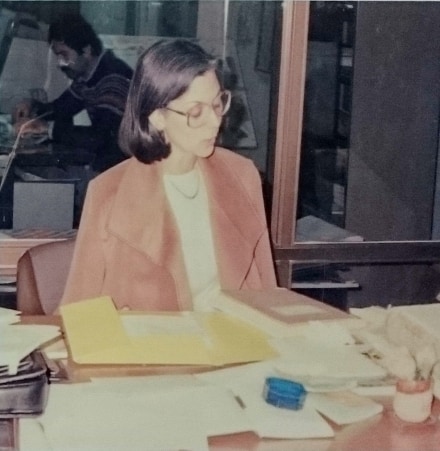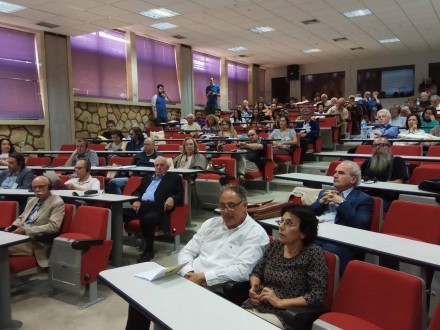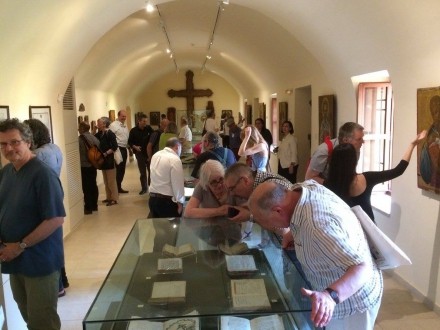Making (printing) history in Crete: the annual conference of the AEPM
The 2017 edition of the AEPM’s annual conference was hosted by the Museum of Typography in Souda, next to the historic town of Chania in the North West of Crete. From 11-14 May, it brought together fifty-five participants from eleven countries including South Korea. A notable innovation this year was the presence of several delegates from museums with modest budgets which do not normally stretch to this kind of meeting. This was made possible by generous bursaries offered by our hosts on the occasion of an award which the Museum of Typography recently received from the Greek graphic design community for its contribution to printing culture.
Exceptionally, the conference followed hard on the heels of two other recent AEPM events: the participation of a delegation of thirty representatives from European printing museums at a meeting in Cheongju City in South Korea in September 2016 to mark the launching of a project to set up a worldwide network of printing museums; and the 2016 annual conference of the Association which was held in November at the Dutch Lithography Museum. This unusually busy programme of events was the result of the decision taken in 2015 to hold the annual conference in the Spring, as of 2017, in order to bring it into line with the AEPM’s recently acquired status as a Brussels-registered not-for-profit association (Asbl).
The conference was spread over three and a half days with the usual mix of talks, informal discussions and visits. Many new people attended, taking advantage of the event to discover aspects of the printing heritage scene in Greece and share ideas with colleagues from printing museums and heritage workshops from all over Europe. Our host, the Museum of Typography, was of course no stranger to the AEPM, having attended previous conferences at the Musée de l’imprimerie et de la communication in Lyon (France, 2012) and the Tipoteca italiana in Cornuda (Italy, 2015).
The theme of the conference – Making history: collections, collectors and the cultural role of printing museums – was, as ever, fairly open-ended with a broad diversity of perspectives: printing museums old and new, collectors of machines, graphic designers and practising printers with a historic turn of mind, teachers, researchers and printing historians. Of particular interest this year was the presence of collectors of historical printing machines and representatives of several current projects to set up new printing museums. As for the fourteen speakers, they were of a consistently high quality, focused and – it has to be said – remarkably disciplined as they managed to keep to the timetable despite a very busy programme and sessions in different locations (the Regional Press Institute and the Mediterranean Agronomic Institute) owing to the fact that the Museum of Typography’s amphitheatre was not big enough to house all the delegates.
The opening session on the Thursday evening took place in the Centre for Mediterranean Architecture which is housed in the restored Arsenal in the heart of the old Venetian port of Chania. Several speakers spoke to a large audience composed not only of the conference delegates, but also of representatives of the Greek printing and newspaper industry and the many local partners who had supported the Museum in organising the conference.
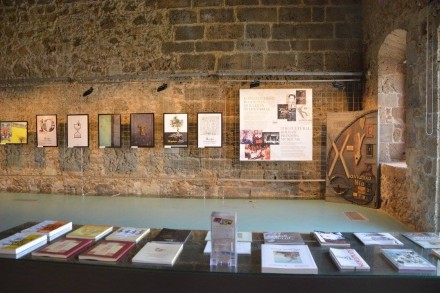
The Centre for Mediterranean Archicture also housed an exhibition about the Museum, its activities and a selection of the works submitted in recent years for its poster competition on the theme of typography. (Photo: Museum of Typography.)
After the welcome address by Yiannis Garedakis who situated the Museum of Typography and the conference in the context of Crete and its economic activity, the governor of the island and the Mayor of Chania paid homage to the Museum of Typography and its founders Yiannis and Eleni Garedakis. Yiannis Phillis, senior professor at Crete Technical University then made a vibrant case for the importance of museums in general and of printing museums in particular as measures and vectors of intellectual progress, culture and democracy. Alan Marshall, chair of the AEPM, continued with an outline of the origins of printing museums and their evolution in parallel with that of the printing industry and the historical disciplines which underpin their missions and activities. Michael Meimaris, emeritus professor at the University of Athens, closed the session with an evocation of an augmented reality project centred round the Museum of Typography.

Friday evening ended with a dinner offered by the Municipality of Chania and accompanied by an excellent fifteen-piece orchestra with an astonishingly broad repertoire. (Photo: Mana Kaasik, Estonian Printing Museum)
On Friday morning, before getting down to the ‘serious’ work of the conference, delegates had time to visit the Typography Museum, located in the nearby port town of Souda, and get acquainted with its collections and activities. It was also the occasion to get to know its staff and collaborators and take the measure of the work which has been accomplished in the thirty years since Yiannis and Eleni Garedakis first started to formulate the idea of starting up a printing museum.
Today, Yiannis is at the head of the country’s leading regional daily newspaper, the Haneotica Nea (Chania News) an entreprise which he started fifty years ago in the difficult days the Greek Junta which for seven years was particularly hostile to any form of press freedom.
He had started his career as a young journalist in Athens where he discovered the work and traditions of the compositors, linotype operators and printers. Over the years, he collected a certain number of printing machines which would later form the basis of the Museum of Typography which he set up with his wife and collaborator Eleni on the premises of their newspaper’s printing plant. For the last thirty years, they have continued to add to the collection, first printing machines representing most of the principal printing techniques and, later, a wide selection of printed documents of all sorts and from all periods in the Greek language. In recent years, the Museum has virtually doubled in size (extending into a former machine hall belonging to the newspaper) and adding new exhibition space, an auditorium, a shop and a café. No printing museum could better illustrate the theme of the conference than the Museum of Typography: a private collection become museum thanks to the will, persistence and generosity of two people actively involved in printing and publishing. (It is worth noting that, to mark the AEPM conference in Chania, Haneotika Nea published a well-produced, informative study of Cretan scholars and printers from the fifteenth through to the nineteenth century (Electra Kambouraki-Pateraki, Cretan scholars and printers.)
Friday’s session covered several aspects of the development of Greek typography and reminded delegates unfamiliar with the history of Greece that printing was not introduced into Greece until fairly recent times, Greek language works being imported during the first centuries of printing from major printing centres elsewhere in Europe, notably from Venice. This of course did not prevent Greek typography from having a rich and illustrious history which was evoked with admirable clarity by the architect and book historian Konstantinos Staikos and Giorgios Matthiopoulos of the Technical Education Institute of Athens, notably through the development of Greek-language printing and publishing, and the development of Greek typographical letterforms from Byzantine writing.
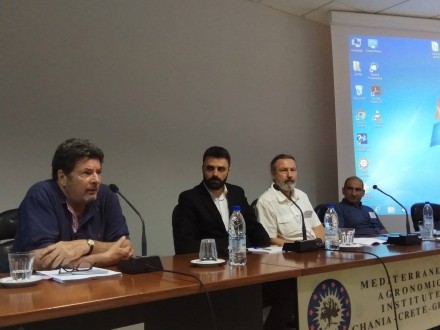
From left to right: Konstantinos Staikos, Paraskevas Perakis, Georgios Matthiopoulos and Gerry Leonidas. (Photo: Haneotika Nea.)
Gerry Leonidas from the Department of typography and graphic communication (Reading, UK) provided a masterly exposition of a methodology for looking at, analysing and describing graphic objects of all sorts: a methodology which would be of very considerable interest to printing museum personnel who are regularly confronted by the need to make the often inscrutable technical and printed artefacts which are their daily lot intelligible for non-specialists. His limpid exposition offered one possible answer to the chronic lack of specialist training for people working in the field of graphic heritage.
The afternoon session approached more directly various questions concerning printing museums and the exploitation of graphic heritage materials. Guy Hutsebaut gave an account of the recent (2016) makeover of the Plantin-Moretus Museum in Antwerp, the specific problems raised by exhibiting fragile printed objects in the context of a historic site, and the difficulty of striking a balance between display and conservation and between the clarity of the narrative and faithfulness to a particular historical period.
The two following speakers, Jürgen Bönig and Patrick Goossens dealt directly, each in his own way with the question of collections as the raw material of museums. Jürgen’s case was that of a historical typographical collection – that of the J. J. Augustin printing firm in Glückstadt in Germany which, as of the turn of the twentieth century, specialised in the printing of works in a wide variety of languages and scripts. This unique collection is now the object of a museum in the making which deals not only with the practicalities of printing techniques but also with the cultural diversity of typographical writing systems on an international scale. In contrast, Patrick provided us with an insight into his extraordinary collection of printing machines and the many questions he has to confront with respect to what he collects, why he collects it, and the perspectives for short-term exploitation and long-term survival of his collection. One of the aspects he emphasised was the restauration and practical use of typefounding, typesetting and printing machines as a means of fully understanding former production methods.
The afternoon session also took us to Cyprus to look at projects aimed at giving greater prominence to the island’s graphic heritage. Niki Sioki from the University of Nicosia spoke about several collections of printed ephemera which for the moment are somewhat dispersed and underexploited as such, and how a digitisation campaign might make them more accessible as a tool for studying the history of the island’s graphic production. Klimis Mastoridis, also from the University of Nicosia described several collections of printing machines which have the potential to form the basis of a future printing museum in Cyprus, and the challenges which such a project would have to face.
Friday ended with dinner in a highly reputed taverna on the nearby peninsula of Akrotiri with a moonlit view over the bay of Souda and animated by two local musicians and a group of traditional Cretan dancers. Inevitably the music got the better of the Greek contingent who occupied the dance floor, joined by some of the more intrepid foreign delegates.
The Saturday session was held at the Regional Press Institute, a conference centre located about twenty kilometres from Chania in the foothills of the spectacular and still partially snow-covered White Mountains. After the annual general meeting of the AEPM, Sonja Neumann of the Deutsches Museum in Munich gave us a thought-provoking analysis of the many questions facing printing museums in the information age, based on her work on the reinstallation of her museum’s printing gallery which is currently underway. No sector of museum activity, whether conservation, restoration, exhibition or mediation, escapes the many thorny problems raised by the third industrial revolution and its impact on the forms, functions and interpretation of graphic artefacts.
The following speakers concerned themselves, in very different ways, with the necessarily close relationship between graphic heritage and graphic design. Anastasios Politis of the Hellenic Union of Graphic Arts and Media Technology Engineers revisited the role of typography in modern visual communication, underlining the need to maintain an active link between graphic design and graphic heritage. Sue Walker, from the University of Reading described the many ways in which the extensive historical collections of the Department of typography & graphic communication (UK) are used on a daily basis to give students, for the most part destined to become practising graphic designers, a firm grounding in the history of printing and design history. The success of this approach, which has been followed for over forty years, is attested by the number, not only of highly qualified graphic and type designers to have come out of the Department of typography, but also the number of teachers and former students who have made their mark in printing and design history over the last two generations.
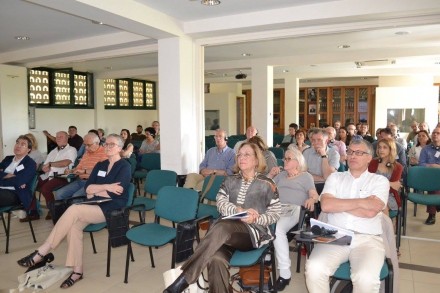
An attentive audience for the Saturday session at the Regional Press Institute. (Photo: Haneotika Nea.)
The session concluded with news from several member organisations:
- Pascal Fulacher spoke about the Atelier du livre d’artiste et de l’estampe (Imprimerie nationale, Paris), its installation in the IN’s principal production site at Douai in the North-East of France, and its project to establish a printing museum.
- Sora Kim of the Jijki festival in Cheongju City (South Korea) brought news of the City’s initiative to set up an International Association of Printing Museums (IAPM).
- Robin Boone described preparations for a series of coordinated printing history exhibitions which will take place in 2018-2019 in several Belgian museums including the Plantin-Moretus (Antwerp), the MIAT (Ghent), the National Playing Card Museum (Turnhout) and the Centre de la gravure et de l’image imprimée (La Louvière).
- José Bermejo, director of Madrid’s city museums and former director of the Imprenta Municipal which will host next year’s AEPM conference, raised the idea of making bookbinding the theme of the 2019 Madrid event: partly because several institutions in the city possess exceptional collections in the field, but also because bookbinding raises many questions for printing museums and can often present problems, whether from a technical, conservation or display point of view.
- Jadwiga Tryzno, who was present with her husband Pawel, spoke about the collections and activities of the Book Art Museum in Lodz in Poland which combines specialised practical knowledge of typesetting and printing techniques with a very active programme of high quality book production. The Museum – which she described as a “squat museum” (perhaps the only one in Europe?) – has for twenty-three years led a rich but sometimes rather precarious life with periodical threats of expulsion from their current premises.
- Sue Shaw evoked The Type Archives’ (London) current projects and the importance of readers and writers in any reflection on the whys and wherefores of printing and related museums.
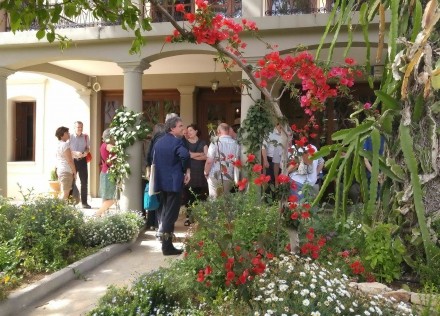
Delegates arriving at the Elephtherios Venizelos Museum; (Photo: Mana Kaasik, Estonian Printing Museum.)
Saturday afternoon and Sunday were given over to visits and excursions offered by the Museum of Typography and its various partners in organising the conference. First stop was the residence of the statesman Eleftherios Venizelos, one of modern Greece’s founding fathers, who was born and spent much of his life in Chania where he had been instrumental in obtaining for the island of Crete its independence from the Ottoman empire and later its full integration as part what we now know as Greece. This was followed by a visit to the Holy Trinity Monastery on the peninsula of Akrotiri which in addition to its wine cellars houses a small permanent exhibition of highlights from its rare book collection.
Sunday took us to the Botanical Park and Gardens of Crete in the foothills of the White Mountains, a magnificent 20-hectare domain which, though barely fifteen years old – it was set up after a disastrous fire in 2003 – offers a fabulous diversity of plants in the three different ecosystems present on the site: sub-tropical, Mediterranean and mountain.
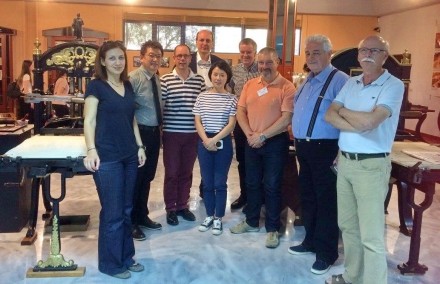
From left to right: Elia Koumi, Dr Seung-choul Lee, Frédéric Terrier, Patrick Goossens, Sora Kim, Stefan Soltek, Guy Hutsebaut, Yiannis Garedakis, Alan Marshall.
Sunday morning, before the excursion, also gave several members of the newly-elected board of the AEPM and the Typography Museum an opportunity to meet with Dr Seung-cheol Lee and his collaborateur Sora Kim to discuss the initiative of Cheongju City and the Jikji Festival in South Korea to organise a working group to prepare the setting up of the International Association of Printing Museums. The working group – which will meet in October of this year – will include several representatives from the AEPM.
Our three and half days in Chania were dense, with long days and short nights – studious and hilarious by turns, but always convivial thanks to the discrete but well-oiled organisation of the event and, above all, the legendary, and unforgettable, hospitality of the Museum of Typography. Our warmest thanks go to Eleni and Yiannis Garedakis, the Museum’s director Elia Koumi, and all the Museum’s collaborators and partners who helped make the event such a success.
Alan Marshall
